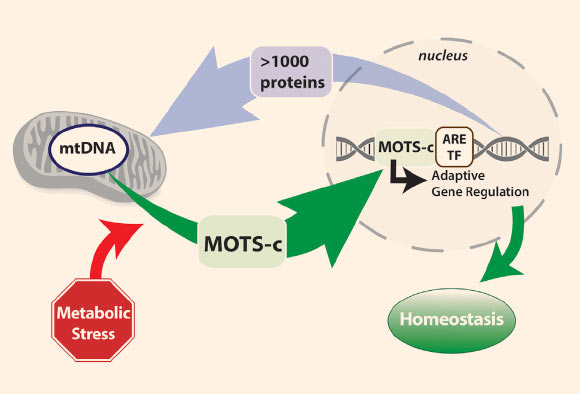Transfer of vital genetic information within a cell isn’t the one-way telegraph, according to a new study published in the journal Cell Metabolism.

The mitochondrial genome is regulated by factors encoded in the nucleus. Kim et al now show that a mitochondrial-encoded protein called MOTS-c can dynamically translocate to the nucleus in response to metabolic stress and regulate adaptive nuclear gene expression; the findings suggest that mitonuclear communication is genetically integrated. Image credit: Kim et al, doi: 10.1016/j.cmet.2018.06.008.
Mitochondria are the structures within cells mostly known for converting nutrients into usable energy.
Most genetic material resides in the nucleus, which is the largest component of the cell. Its DNA sends coded templates telling the cell what to do.
The mitochondria also contain DNA, all of it inherited from the mother, and as the new study shows, they are not just taking orders from the nucleus.
“Mitochondria have their own DNA that presumably comes from ancient bacteria that joined our cells a long time ago,” said senior author Dr. Changhan David Lee, from the University of Southern California, Los Angeles, the USC Norris Comprehensive Cancer Center, and Ajou University in Suwon, Republic of Korea.
“We didn’t know that our mitochondrial DNA encoded messages to control the nucleus.”
“This is a fundamental discovery that integrates our two genomes as a co-evolved genetic system and may have a lasting impact for a broad range of scientific and medical fields.”
“Understanding how intracellular DNA communication is hardwired into the cell will lead more researchers to appreciate the coordination of genes encoded in both genomes and their role in aging and disease,” he added.
“Our findings are significant because aging causes cells to break down, leading to diseases such as cancer and Alzheimer’s.”
Working with human cells, Dr. Lee and co-authors discovered that when a cell is under stress and starved for nutrients, MOTS-c, a small protein encoded in the mitochondria DNA, moves into the nucleus to control genes and turn on a defensive system, including an antioxidant response.
“Knowing intimately how cells operate could lead to greater understanding of age-related disease and, perhaps one day, new mitochondria-based treatments,” the researchers said.
“Prescription drugs today are designed based on the blueprint encoded in the nuclear genome.”
“We haven’t been looking at the full complexity of the cellular network. If we’re fighting cancer, for example, with only half of our genome, then it’s half of a solution. Now we can fight these diseases with all our genetic components,” Dr. Lee said.
_____
Kyung Hwa Kim et al. The Mitochondrial-Encoded Peptide MOTS-c Translocates to the Nucleus to Regulate Nuclear Gene Expression in Response to Metabolic Stress. Cell Metabolism, published online July 5, 2018; doi: 10.1016/j.cmet.2018.06.008







